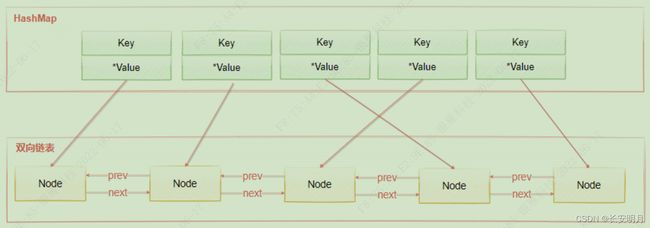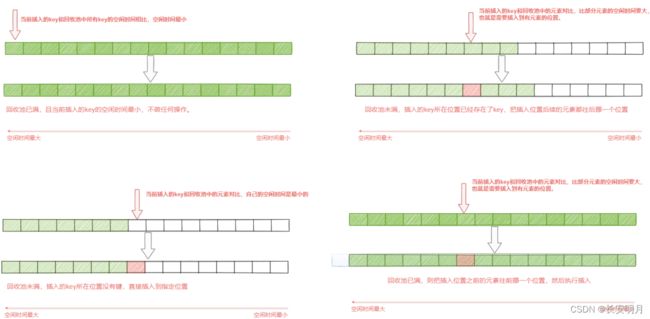Redis 内存淘汰策略
一、什么是内存淘汰?
如果在做项目时,不计任何后果地把任何数据都往 Redis 写入,使用不合理很容易导致数据超过Redis 的最大内存,这种情况就会导致如下问题。
- Redis 中有很多无效的缓存,这些缓存数据会降低 IO 性能。
- 随着系统的运行,Redis 的数据越来越多,会导致物理内存不足。虽然可以通过使用虚拟内存,将很少访问的数据交换到磁盘上,腾出内存空间的方法来解决物理内存不足的问题,但是由于这部分数据存储在磁盘上,如果在高并发场景中,频繁访问虚拟内存空间会严重降低系统性能。
所以遇到 Redis 内存不足的问题时,我们一般有几种方法:
- 对每个存储到 Redis 中的 key 设置过期时间,这个根据实际业务场景来决定。否则,再大的内存都会随着系统运行被消耗完;
- 增加内存;
- 使用内存淘汰策略。
当内存空间使用达到限制时,Redis 会根据配置策略来选择不同处理方式,要么返回 errors,要么按照不同的策略算法来清除一些旧数据,达到回收内存的目的,这就是 Redis 的内存淘汰,有些文章中,内存淘汰也叫缓存回收。
本文以 Linux 系统安装的 4.0.8 版本的 Redis 为例,对内存淘汰策略进行总结。Redis 的最大内存上限、淘汰算法的配置都在 redis.conf 文件中有说明,现在把 redis.conf 中对内存管理的部分内容摘录如下。
############################## MEMORY MANAGEMENT ################################
# Set a memory usage limit to the specified amount of bytes.
# When the memory limit is reached Redis will try to remove keys
# according to the eviction policy selected (see maxmemory-policy).
#
# If Redis can't remove keys according to the policy, or if the policy is
# set to 'noeviction', Redis will start to reply with errors to commands
# that would use more memory, like SET, LPUSH, and so on, and will continue
# to reply to read-only commands like GET.
#
# This option is usually useful when using Redis as an LRU or LFU cache, or to
# set a hard memory limit for an instance (using the 'noeviction' policy).
#
# WARNING: If you have slaves attached to an instance with maxmemory on,
# the size of the output buffers needed to feed the slaves are subtracted
# from the used memory count, so that network problems / resyncs will
# not trigger a loop where keys are evicted, and in turn the output
# buffer of slaves is full with DELs of keys evicted triggering the deletion
# of more keys, and so forth until the database is completely emptied.
#
# In short... if you have slaves attached it is suggested that you set a lower
# limit for maxmemory so that there is some free RAM on the system for slave
# output buffers (but this is not needed if the policy is 'noeviction').
#
# maxmemory <bytes>
# MAXMEMORY POLICY: how Redis will select what to remove when maxmemory
# is reached. You can select among five behaviors:
#
# volatile-lru -> Evict using approximated LRU among the keys with an expire set.
# allkeys-lru -> Evict any key using approximated LRU.
# volatile-lfu -> Evict using approximated LFU among the keys with an expire set.
# allkeys-lfu -> Evict any key using approximated LFU.
# volatile-random -> Remove a random key among the ones with an expire set.
# allkeys-random -> Remove a random key, any key.
# volatile-ttl -> Remove the key with the nearest expire time (minor TTL)
# noeviction -> Don't evict anything, just return an error on write operations.
#
# LRU means Least Recently Used
# LFU means Least Frequently Used
#
# Both LRU, LFU and volatile-ttl are implemented using approximated
# randomized algorithms.
#
# Note: with any of the above policies, Redis will return an error on write
# operations, when there are no suitable keys for eviction.
#
# At the date of writing these commands are: set setnx setex append
# incr decr rpush lpush rpushx lpushx linsert lset rpoplpush sadd
# sinter sinterstore sunion sunionstore sdiff sdiffstore zadd zincrby
# zunionstore zinterstore hset hsetnx hmset hincrby incrby decrby
# getset mset msetnx exec sort
#
# The default is:
#
# maxmemory-policy noeviction
# LRU, LFU and minimal TTL algorithms are not precise algorithms but approximated
# algorithms (in order to save memory), so you can tune it for speed or
# accuracy. For default Redis will check five keys and pick the one that was
# used less recently, you can change the sample size using the following
# configuration directive.
#
# The default of 5 produces good enough results. 10 Approximates very closely
# true LRU but costs more CPU. 3 is faster but not very accurate.
#
# maxmemory-samples 5
二、Redis 内存上限
Redis 的最大内存上限可以在配置文件 redis.conf 中配置,redis.conf 配置如下:
# maxmemory <bytes>
设置 maxmemory 为 0 表示没有内存限制。在 64 位系统中,默认是 0 无限制,但是在 32 位系统中默认是 3GB。
三、Redis 内存淘汰策略
Redis 提供了一种内存淘汰策略,当内存不足时,Redis 会根据相应的淘汰规则对 key 数据进行淘汰。 Redis 的内存淘汰策略共有 8 种具体的淘汰策略,默认的策略为 noeviction,当内存使用达到阈值的时候, 所有引起申请内存的命令会报错。8 种淘汰策略如下所示。
- volatile-lru:当内存不足时,从设置了过期时间的 key 中使用 LRU 算法,选出最近使用最少的数据进行淘汰;
- allkeys-lru:当内存不足时,从所有 key 中使用 LRU 算法,选出最近使用最少的数据进行淘汰;
- volatile-lfu:当内存不足时,从设置了过期时间的 key 中使用 LFU 算法,选出使用频率最低的数据进行淘汰;
- allkeys-lfu:当内存不足时,从所有 key 中使用 LFU 算法,选出使用频率最低的数据,进行淘汰;
- volatile-random:当内存不足时,从设置了过期时间的 key 中,随机选出数据进行淘汰;
- allkeys-random:当内存不足时,从所有的 key 中,随机选出数据进行淘汰;
- volatile-ttl:当内存不足时,从设置了过期时间的 key 中,选出即将过期的数据(按照过期时间的先后,选出最先过期的数据)进行淘汰;
- noeviction: 当内存不足时,禁止淘汰数据,写入操作报错。这是 Redis 默认的内存淘汰策略。
前缀为 volatile- 和 allkeys- 的区别在于二者选择要清除的键时的字典不同,volatile- 前缀的策略表示从 redisDb 中的过期字典中选择键进行清除;allkeys- 开头的策略代表从 dict 字典中选择键进行清除。
策略中用到的两种算法:
- LRU(Least Recently Used):最近最少使用。优先淘汰使用时间最远的数据。
- LFU(Least Frequently Used):最小频率使用。优先淘汰最不常用的 Key。
四、内存淘汰的具体工作步骤
- 客户端执行一条新命令,导致数据库需要增加数据(比如 set key value);
- Redis 会检查内存使用情况,如果内存使用超过 maxmemory 设置的值,就会按照内存淘汰策略删除一些 key;
- 新的命令执行成功。
五、LRU 算法及在 Redis 中的改进
5.1 LRU 算法
LRU 是 Least Recently Used 的缩写,也就是表示最近最少使用,也可以理解成最久没有使用。也就是说当内存不够的时候,每次添加一条数据,都需要抛弃一条最久时间没有使用的旧数据。标准的 LRU 算法为了降低查找和删除元素的时间复杂度,一般采用 Hash 表和双向链表结合的数据结构,Hash 表可以快速查找到某个 key 是否存在链表中,同时可以快速删除、添加节点,如下图所示。

双向链表的查找时间复杂度是 O(n),删除和插入是 O(1),借助 HashMap 结构,可以使得查找的时间复杂度变成 O(1)。
Hash 表用来查询在链表中的数据位置,链表负责数据的插入,当新数据插入到链表头部时有两种情况。
- 链表满了,把链表尾部的数据丢弃掉,新加入的缓存直接加入到链表头中。
- 当链表中的某个缓存被命中时,直接把数据移到链表头部,原本在头节点的缓存就向链表尾部移动。
这样,经过多次 Cache 操作之后,最近被命中的缓存,都会存在链表头部的方向,没有命中的,都会在链表尾部方向,当需要替换内容时,由于链表尾部是最少被命中的,我们只需要淘汰链表尾部的数据即可。
5.2 Redis 中的 LRU 算法
实际上,Redis 使用的 LRU 算法是一种不可靠的 LRU 算法,它实际淘汰的键并不一定是真正最少使用的数据。它的工作机制是:
- 随机采集淘汰的 key,每次随机选出 5 个key;
- 然后淘汰这 5 个 key 中最少使用的 key。
这 5 个 key 是默认的个数,具体的数值可以在 redis.conf 中配置。
maxmemory-samples 5
当近似 LRU 算法的抽样值越大时就越接近真实的 LRU 算法,因为取值越大获取的数据越完整,淘汰的数据就更加接近最少使用的数据,但是消耗的 CPU 更多。抽样值越小,算法运行更快,但是准确度越低。这里涉及一个权衡问题,如果需要在所有的数据中搜索最符合条件的数据,那么一定会增加系统的开销。Redis 是单线程的,所有耗时的操作都要谨慎一些。为了在一定成本内实现相对的 LRU,早期的 Redis 版本是基于采样的 LRU,也就是放弃了从所有数据中搜索解,改为在采样空间搜索最优解。Redis 3.0 版本之后,Redis 作者对基于采样的 LRU 进行了一些优化:
- Redis 中维护一个大小为 16 的候选池,当第一次随机选取采样数据时,会把数据放入到候选池中,并且候选池中的数据会根据 key 的空闲时间进行排序。
- 当第二次以后选取数据时,只有大于候选池内最小空闲时间的 key 才会被放进候选池(空闲时间越大,代表越久没有被使用,准备淘汰))。
- 当候选池的数据满了之后,那么空闲时间最大的 key 就会被挤出候选池。当执行淘汰时,直接从候选池中选取空闲时间最大的 key 进行淘汰。
如下图所示,首先从目标字典中采集出 maxmemory-samples 个键,缓存在一个 samples 数组中,然后从 samples 数组中一个个取出来,和回收池中的键进行键的空闲时间比较,从而更新回收池。在更新过程中,首先遍历找到每个键的实际插入位置 x,然后根据不同情况进行处理。
- 回收池满了,并且当前插入的 key 的空闲时间最小(也就是回收池中的所有 key 都比当前插入的 key 的空闲时间大),则不作任何操作。
- 回收池未满,并且插入的位置 x 没有键,则直接插入即可。
- 回收池未满,且插入的位置 x 原本已经存在要淘汰的键,则把第 x 个以后的元素都往后挪一个位置,然后再执行插入操作。
- 回收池满了,将当前第 x 个以前的元素往前挪一个位置(实际就是淘汰了),然后执行插入操作。
这样做的目的是能够选出最真实的最少被访问的 key,能够正确选择不常使用的 key。因为在Redis 3.0 之前是随机选取样本,这样的方式很有可能不是真正意义上的最少访问的 key。LRU 算法有一个弊端,假如一个 key 值访问频率很低,但是最近一次被访问到了,那 LRU 会认为它是热点数据,不会被淘汰。同样,经常被访问的数据,最近一段时间没有被访问,这样会导致这些数据被淘汰掉,导致误判而淘汰掉热点数据,于是在 Redis 4.0 中,新加了一种 LFU 算法。
六、LFU
LFU(Least Frequently Used),表示最小频率使用,它和 key 的使用次数有关。其思想是:根据 key 最近被访问的频率进行淘汰,比较少访问的 key 优先淘汰,反之则保留。LFU 的原理是使用计数器来对 key 进行排序,每次 key 被访问时,计数器会增大,当计数器越大,意味着当前 key 的访问越频繁,也就是意味着它是热点数据。 它很好的解决了 LRU 算法的缺陷:一个很久没有被访问的 key,偶尔被访问一次,导致被误认为是热点数据的问题。LFU 的实现原理如下图所示,LFU 维护了两个链表,横向组成的链表用来存储访问频率,每个访问频率的节点下存储另外一个具有相同访问频率的缓存数据。具体的工作原理是:
- 当添加元素时,找到相同访问频次的节点,然后添加到该节点的数据链表的头部。如果该数据链表满了,则移除链表尾部的节点;
- 当获取元素或者修改元素时,都会增加对应 key 的访问频次,并把当前节点移动到下一个频次节点。
添加元素时,访问频率默认为 1,随着访问次数的增加,频率不断递增。而当前被访问的元素也会随着频率增加进行移动。

文章参考:
- Redis内存淘汰策略
- Redis的内存淘汰策略(八)
